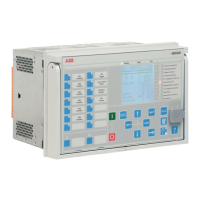Address Register Values Description
: : : :
49329 Sequence Number 8 Event record 8
: : : :
49340 Sequence Number 9 Event record 9
: : : :
49351 Sequence Number 10
Event record 10
49352 Unread records left 10
49353 TimeStamp 10
49354 TimeStamp 10
49355 TimeStamp 10
49356 TimeStamp 10
49357 Event Type 10
49358 Data Object Id 1_10
49359 Data Object Id 2_10
49360 Data Value 10
49361 Data Value 10
3.4.10 Fault records
A fault record is created by the IED as a set of registrations during a detected fault
period. The registration includes the selected peak values and the global duration
value of the protection stages, the time of recording and a sequence number for the
fault record.
The size of the IED's internal Modbus fault record buffer is 100 records. The 100 latest
fault records are at any time readable from the IED. The Modbus fault record is
Modbus dependent and the data organization and buffer size differ from the IED's
initial system level registrations. When the Modbus fault record buffer becomes full,
the IED overwrites the oldest records in the buffer.
Multiple clients support
Several Modbus clients can independently of one another read out the Modbus fault
records from the IED. The Modbus fault record buffer keeps track of where in the
buffer the different clients are reading at the moment. Clients are identified either by
the serial port from where the requests are issued or by the client's IP address in the
TCP/IP network.
3.4.10.1 Fault record structure
The IED's fault record structure starts from the location 49401 and consists of a fixed
header part and an application data part. The application data part is always IED type
specific. The whole fault record including the IED-specific application data part is
found in the Modbus memory map section.
Section 3 1MRS757645 B
Vendor-specific implementation
56 620 series
Communication Protocol Manual

